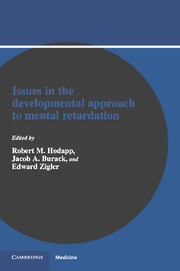Book contents
- Frontmatter
- Contents
- Preface
- Contributors
- Part 1 Developmental theory
- Part 2 Applying developmental theory to different types of retarded individuals
- 7 Cultural–familial mental retardation: A developmental perspective on cognitive performance and “helpless” behavior
- 8 The organization and coherence of developmental processes in infants and children with Down syndrome
- 9 Developmental issues in fragile X syndrome
- 10 Deviance and developmental approaches in the study of, autism
- 11 The issues of multiple pathways in the development of handicapped children
- 12 Summing up and going forward: New directions in the developmental approach to mental retardation
- Author index
- Subject index
8 - The organization and coherence of developmental processes in infants and children with Down syndrome
from Part 2 - Applying developmental theory to different types of retarded individuals
Published online by Cambridge University Press: 07 September 2010
- Frontmatter
- Contents
- Preface
- Contributors
- Part 1 Developmental theory
- Part 2 Applying developmental theory to different types of retarded individuals
- 7 Cultural–familial mental retardation: A developmental perspective on cognitive performance and “helpless” behavior
- 8 The organization and coherence of developmental processes in infants and children with Down syndrome
- 9 Developmental issues in fragile X syndrome
- 10 Deviance and developmental approaches in the study of, autism
- 11 The issues of multiple pathways in the development of handicapped children
- 12 Summing up and going forward: New directions in the developmental approach to mental retardation
- Author index
- Subject index
Summary
Goals of this chapter
In this chapter, we examine the applicability of an organizational developmental perspective to the study of infants and children with Down syndrome. Specifically, we review the knowledge base on temperament and socioemotional, cognitive, and representational development, focusing on whether children with Down syndrome proceed through the same sequences, stages, and structures in these domains as nonhandicapped children. Moreover, we explore both qualitative and quantitative differences, in addition to similarities, in the development of children with Down syndrome and normal youngsters. Finally, we determine whether, despite the differences that do exist, the development of children with Down syndrome is organized, meaningful, and lawful – in short, coherent.
Introduction
Over the past several decades, research on Down syndrome from a developmental perspective has burgeoned (see Cicchetti and Beeghly, in press). Prior to these efforts, theoreticians and researchers had primarily conceptualized the developmental process of children with Down syndrome as being qualitatively different from that of MA-matched nonhandicapped children (Cicchetti & Pogge-Hesse, 1982; Gibson, 1978). Historically, this issue has been examined within the context of the developmental–difference controversy in the field of mental retardation (Zigler, 1969; Zigler & Balla, 1982).
According to the classic developmental model, explicated most lucidly by Zigler (1969, 1973) and intended to apply only to retarded persons free from organic involvement (i.e., individuals with cultural–familial mental retardation), the retarded child is thought to progress through the cognitive-developmental stages in the same sequence as the nonhandicapped child, albeit at a slower pace and with a lower asymptote.
- Type
- Chapter
- Information
- Issues in the Developmental Approach to Mental Retardation , pp. 169 - 225Publisher: Cambridge University PressPrint publication year: 1990
- 20
- Cited by

